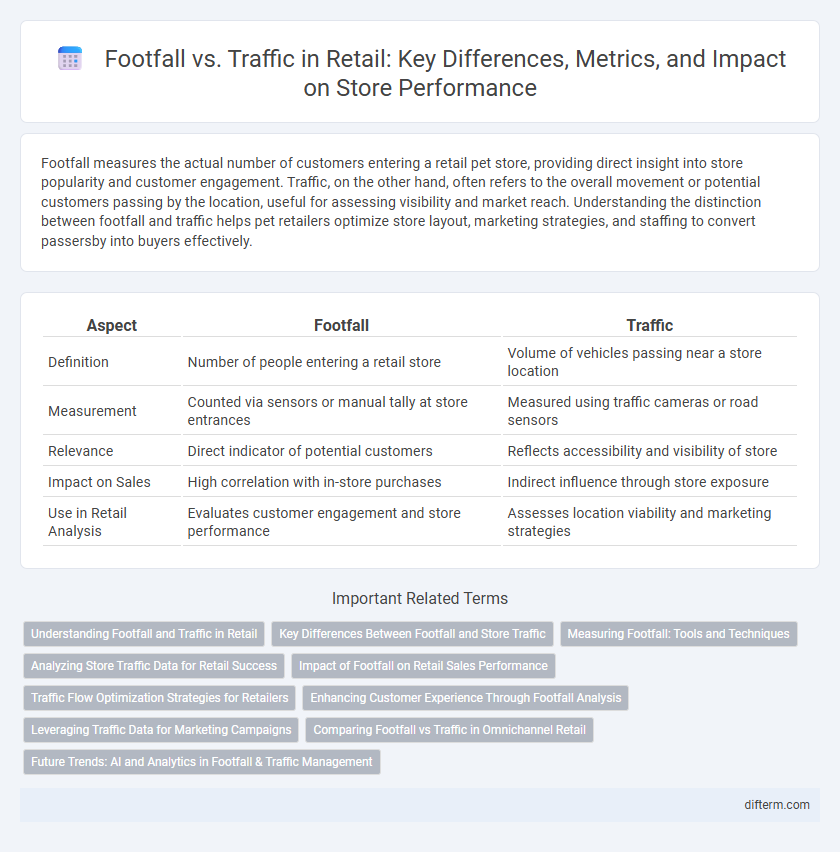Footfall measures the actual number of customers entering a retail pet store, providing direct insight into store popularity and customer engagement. Traffic, on the other hand, often refers to the overall movement or potential customers passing by the location, useful for assessing visibility and market reach. Understanding the distinction between footfall and traffic helps pet retailers optimize store layout, marketing strategies, and staffing to convert passersby into buyers effectively.
Table of Comparison
| Aspect | Footfall | Traffic |
|---|---|---|
| Definition | Number of people entering a retail store | Volume of vehicles passing near a store location |
| Measurement | Counted via sensors or manual tally at store entrances | Measured using traffic cameras or road sensors |
| Relevance | Direct indicator of potential customers | Reflects accessibility and visibility of store |
| Impact on Sales | High correlation with in-store purchases | Indirect influence through store exposure |
| Use in Retail Analysis | Evaluates customer engagement and store performance | Assesses location viability and marketing strategies |
Understanding Footfall and Traffic in Retail
Footfall in retail refers to the number of customers entering a store, while traffic encompasses all movements within the retail space, including browsing and aisle navigation. Measuring footfall helps retailers gauge overall store popularity, whereas tracking traffic patterns reveals shopper behavior and areas of high engagement. Optimizing both footfall and traffic data enables retailers to enhance store layout, marketing strategies, and ultimately increase sales conversion rates.
Key Differences Between Footfall and Store Traffic
Footfall measures the total number of people entering a retail store during a specific period, serving as a raw indicator of potential customer volume. Store traffic encompasses not only entry counts but also analyzes movement patterns inside the store, including dwell time and navigation paths, providing deeper insights into shopper behavior. While footfall quantifies visitor frequency, store traffic data enables retailers to optimize layout, staffing, and merchandising strategies for improved conversion rates.
Measuring Footfall: Tools and Techniques
Accurate footfall measurement in retail relies heavily on advanced tools such as infrared sensors, video analytics, and Wi-Fi tracking systems that capture customer movement and count store entrants. Implementing heat maps and real-time data analytics provides granular insights into peak hours, dwell times, and customer flow patterns, enabling optimized staffing and layout decisions. Effective footfall tracking directly correlates with enhanced marketing strategies and improved conversion rates by identifying high-traffic zones and consumer behavior trends.
Analyzing Store Traffic Data for Retail Success
Analyzing store traffic data enables retailers to distinguish between overall footfall and quality customer engagement, optimizing merchandising and staffing strategies. Precise measurement of footfall through sensors and AI-driven analytics reveals peak times, customer demographics, and conversion rates, driving targeted marketing efforts. Enhanced understanding of traffic patterns supports inventory management, improves in-store experiences, and ultimately increases sales performance and profitability.
Impact of Footfall on Retail Sales Performance
Footfall directly influences retail sales performance by increasing the number of potential customers entering a store, which enhances sales opportunities. Higher footfall often corresponds to greater product exposure, improving the likelihood of purchases and boosting overall revenue. Analyzing footfall patterns allows retailers to optimize staffing, inventory, and marketing strategies, driving stronger sales outcomes.
Traffic Flow Optimization Strategies for Retailers
Retailers can enhance sales performance by implementing targeted traffic flow optimization strategies that increase footfall and improve customer movement within stores. Techniques such as strategic product placement, clear signage, and intuitive store layouts encourage longer visits and higher conversion rates. Utilizing real-time analytics and heat mapping technology allows retailers to adjust displays and pathways dynamically, maximizing customer engagement and operational efficiency.
Enhancing Customer Experience Through Footfall Analysis
Footfall analysis provides critical insights into customer behavior by tracking the number of visitors entering retail stores, enabling targeted improvements in store layout and staffing to enhance the overall shopping experience. Monitoring footfall patterns helps identify peak hours and optimize resource allocation, ensuring a seamless and personalized interaction that drives customer satisfaction and loyalty. Integrating advanced analytics with real-time data allows retailers to respond dynamically to traffic fluctuations, maximizing engagement and sales opportunities.
Leveraging Traffic Data for Marketing Campaigns
Leveraging detailed traffic data enables retailers to identify peak footfall times and optimize marketing campaigns for maximum engagement and conversion rates. Analyzing customer flow patterns allows targeted promotions and tailored in-store experiences that drive sales and enhance customer retention. Integrating real-time traffic insights with CRM systems provides actionable metrics to refine advertising spend and improve campaign ROI.
Comparing Footfall vs Traffic in Omnichannel Retail
Footfall measures the number of people entering a physical store, while traffic encompasses both online visits and in-store presence, providing a comprehensive view of customer engagement in omnichannel retail. Comparing footfall vs traffic helps retailers evaluate the effectiveness of marketing strategies across digital and physical channels, optimizing customer experience and sales performance. Analyzing these metrics enables data-driven inventory management and personalized promotions, driving higher conversion rates in seamless shopping journeys.
Future Trends: AI and Analytics in Footfall & Traffic Management
AI-driven analytics are revolutionizing footfall and traffic management in retail by enabling real-time data collection and predictive modeling to optimize store layouts and staffing. Advanced sensor technologies combined with machine learning algorithms help retailers accurately track customer movement patterns, enhancing personalized marketing and improving operational efficiency. Future trends indicate increased integration of AI-powered systems for dynamic crowd management and seamless customer experiences, ultimately driving higher conversion rates and revenue growth.
Footfall vs Traffic Infographic

 difterm.com
difterm.com